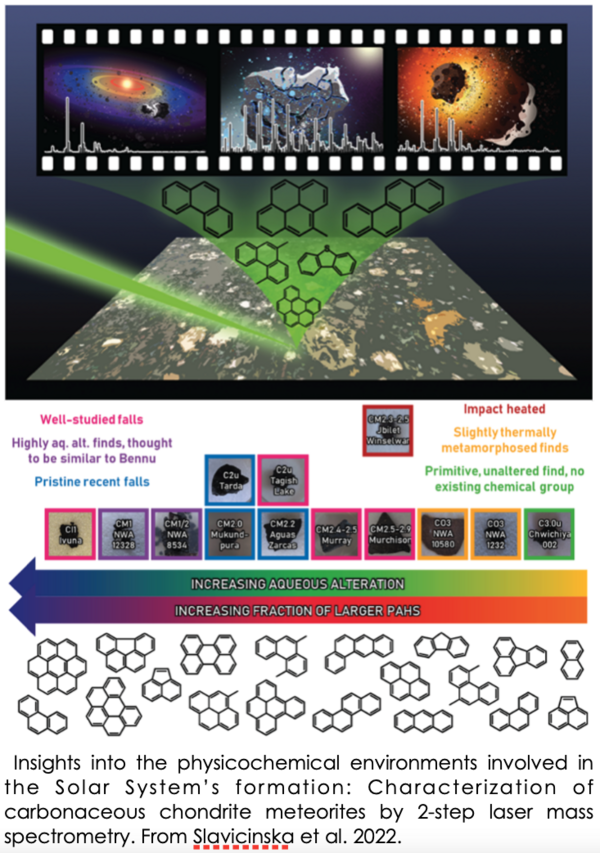Insights into the physicochemical environments involved in the Solar System’s formation: characterization of carbonaceous chondrite meteorites by 2-step laser mass spectrometry
Our aim is to characterize the surface chemical composition and morphology of materials containing carbonaceous inclusions (e.g. meteorites) using our expertise in carbonaceous materials (e.g. soot particles). To achieve this, we use a combination of different techniques: Raman micro-spectrometry, micro-IRTF spectroscopy, resonant laser desorption and ionization/time-of-flight mass spectrometry (IR-LRD/REMPI/TOF-MS), secondary ion mass spectrometry (SIMS) and optical microscopy/ profilometry.
We were able to implement an analytical strategy for the study of a large selection of carbonaceous meteorites with various aqueous alteration characteristics, with the aim of revealing the link between surface chemical composition (by REMPI TOF-MS) and the thermal and aqueous history of these meteorites, precious witnesses of the past and present environment during their formation. This activity was sustained by three accepted projects to host Dr. Bennett in the framework of Labex CaPPA as a Visiting Professor (2019), as part of the UFR de Physique's Visiting Lecturer campaign (2017), as well as, a CNRS Physique Visiting Researcher (2022). In addition, we hosted Ms. K. Slavicinska, a Master's student at UCF (Florida, USA, funded by a NASA Emerging World grant), for 1 month in our laboratory, as soon as sanitary conditions permitted, to carry out the planned experiments on these precious samples. These interactions and research work resulted in an invitation to present our joint research (invited lecture) at the American Chemical Society Spring Meeting, Astrochemical Complexity in Planetary Systems Organics in the Inner Solar system, San Antonio, TX, USA, Virtual, April 9, 2021, and in an invited article in a special issue of the journal ACS Earth and Space Chemistry (SLA-22). This work specifically explores the organic inventories of carbonaceous chondrites (CCs) and provides insights into the physicochemical environments involved in the Solar System’s formation and the post accretionary evolution of meteorite parent bodies.

Studying changes in these inventories across samples that have experienced varying degrees of aqueous/hydrothermal alteration untangles one aspect of such complex records. The polycyclic aromatic hydrocarbon (PAH) and heterocyclic aromatic compound (HAC) contents of 15 CCs representing CI1, CM1, CM2, C2u, C3u, and CO3 classes were probed with two-step laser mass spectrometry (L2MS) and subjected to a comparative principal component analysis (PCA), a multivariate analysis method. PAHs with mass-to-charge ratios (m/z) of 128 to >300 were detected, with large PAHs (4-7 rings) dominating the spectra of the most aqueously altered samples like Ivuna (CI1) and NWA 12328 (CM1), while a larger relative fraction of smaller PAHs (3-4 rings) was observed in less altered samples like Chwichiya 002 (C3.00u). The same trend was observed across CM2 samples with varying degrees of aqueous alteration with the exception of Jbilet Winselwan (CM2.3- 2.5), which has experienced impact shock. Alkylated homologues of C14H10 and C16H10 were detected in all samples, with the latter showing a stronger correlation with aqueous alteration. Additionally, oxygen-containing PAHs and thiophenes were detected. These experiments demonstrate that aqueous alteration induces aromatic condensation in CCs of multiple chemical groups, and many of the 4-7-ring PAHs (>215 m/z) in CCs may be products of aqueous alteration. We evidenced that PAH size distributions are an additional parameter to consider when evaluating a meteorite’s alteration history.
